![]()
![]()
![]()
Use LEFT and RIGHT arrow keys to navigate between flashcards;
Use UP and DOWN arrow keys to flip the card;
H to show hint;
A reads text to speech;
16 Cards in this Set
- Front
- Back
|
What are cytokines?
|
-small soluble messenger proteins
-involved in communication between cells not just cells of the immune system -bind to specific receptors on the membrane of target cells with high affinity (pico-molar concentrations) -they are secreted by a range of cell types in the body (not just immune cells) but not organized in organs -cytokines secreted by one cell type can alter the properties of the cell type producing them or another cell type (autocrine, paracine, & endocrine) |
|
|
What are the actions of cytokines?
|
❤Pleitrophy – acting on different cell types e.g. IL-4 can cause proliferation of B cells, thymocytes & mast cells
❤Redundancy – more than one cytokine mediates the same function e.g. IL-4 & IL-5 can cause B cells to proliferate ❤Synergism - combined effect of 2 or more cytokines is greater than the sum of both cytokines ❤Cascade – activate other cells to release a range of cytokines -the actions of cytokines on target cells depend on binding of the cytokines to specific receptors on the cell surface |
|
|
IL-1
|
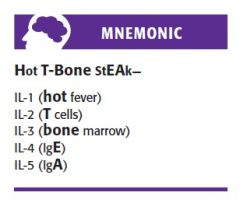
❤SECRETED BY:
Secreted by macrophages (also by leukocytes, fibroblasts and vascular endothelium). ❤STIMULUS: IL-1 production can be triggered by a number of stimuli eg LPS, TNF, IL-1, contact with CD4 T-cells ❤ACTS ON: T cells, B cells, neutrophils, fibroblasts, epithelial cells, hepatocytes ❤ACTION: -causes proliferation of CD4 T-cells and B cells by inducing an increase in IL-2 synthesis -causes acute inflammation -induces chemokine production to recruit leukocytes; activates endothelium to express adhesion molecules -an endogenous pyrogen -IL-1 induces synthesis of IL-6 and acute phase proteins *TNF has similar actions |
|
|
IL-2
|
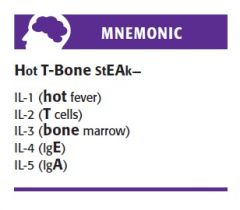
❤SECRETED BY:
It is produced by both CD4 and CD8 T-cells and acts on the secreting cells in an autocrine manner ❤ACTS ON: TH and TC cells ❤ACTION: -stimulates growth of helper and cytotoxic T cells. -IL-2 also stimulates synthesis of other cytokines such as IFN-γ and TNF-β by T-cells -stimulates B cells and Natural Killer (NK) cells |
|
|
IL-3
|
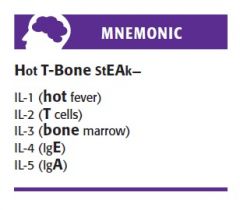
❤SECRETED BY:
Secreted by activated T cells. ❤ACTS ON: Bone marrow stem cells ❤ACTION: Supports the growth and differentiation of bone marrow stem cells. Has a function similar to GM-CSF. |
|
|
IL-4
|

❤SECRETED BY:
Secreted by Th2 cells, NK cells, and by mast cells ❤ACTS ON: B cells. ❤ACTION: Promotes growth of B cells & T cells. Enhances class switching to IgE and IgG.. It also inhibits the production of IFN- γ by T cells and therefore tips the balance towards a TH2 immune response |
|
|
IL-5
|
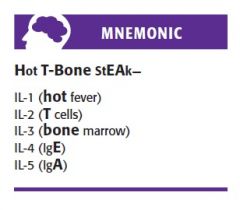
❤SECRETED BY:
Secreted by Th2 cells and by mast cells ❤ACTS ON: B cells, eosinophils. ❤ACTION: Promotes differentiation of B cells. Enhances class switching to IgA. Stimulates production and activation of eosinophils. |
|
|
IL-6
|
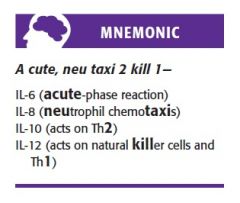
❤SECRETED BY:
Secreted by Th cells, mononuclear phagocytes, endothelial cells, and fibroblasts ❤STIMULUS: Like IL-1 and TNF, IL-6 is secreted into the circulation in response to bacterial infection but seems to be induced by these cytokines (IL-1 and TNF) rather than by LPS itself. ❤ACTS ON: Hepatocytes, B cells. ❤ACTION: Stimulates production of acute-phase reactants and immunoglobulins.It is a principal growth factor for late B-cell differentiation and potent stimulator of bone marrow cell growth. |
|
|
IL-8
|
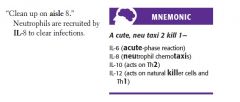
❤SECRETED BY:
IL-8 family are synthesized by antigen-activated T-cells, LPS-activated mononuclear phagocytes, fibroblasts and endothelial cells and platelets. ❤ACTS ON: Neutrophils ❤ACTION: Major chemotactic factor for neutrophils. |
|
|
IL-10
|
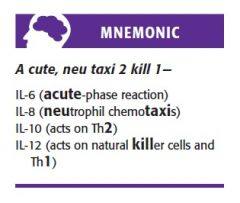
❤SECRETED BY:
Secreted by regulatory T cells. ❤ACTS ON: Th2 and Th1 cells. ❤ACTION: Inhibits actions of activated T cells. Activates Th2, inhibits Th 1 . |
|
|
IL-12
|
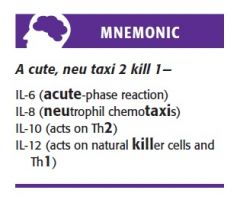
❤SECRETED BY:
Secreted by macrophages & dendritic cells ❤ACTS ON: NK and Th1 cells. ❤ACTION: Activates NK cells. It is the major cytokine to induce differentiation of T cells into TH1 cells. |
|
|
IFN-α and IFN-β
|
❤SECRETED BY:
Most cells ❤ACTS ON: Neighboring cells ❤ACTION: α- and β-interferons inhibit viral protein synthesis. Also cause activation of Natural Killer (NK) Cells. Increases class I MHC expression and boosts CTL-mediated killing. |
|
|
IFN-γ
|
❤SECRETED BY:
Secreted by Th1 cells (also CD 8 cells) upon antigen encounter ❤ACTS ON: Macrophages ❤ACTION: Like IFN-α and IFN-β it is anti-proliferative and induces an anti-viral state Stimulates macrophages, promotes synthesis of enzymes of the respiratory burst and other pro-inflammatory cytokines such as TNF. Activator of neutrophils, inducing the synthesis of enzymes of the respiratory burst. Also a potent activator of natural killer cells and increases the expression of both class I and class II MHC molecules. Activates Th1, inhibits Th2. |
|
|
TNF-α
|
❤SECRETED BY:
Secreted by macrophages and T cells ❤STIMULUS: Lipopolysaccharide (LPS or endotoxin) a component of the cell wall of gram negative bacteria, induces the secretion of TNF-α ❤ACTS ON: Vascular endothelium, monocytes, neutrophils, hepatocytes ❤ACTION: Main points: Mediates septic shock. Causes leukocyte recruitment, vascular leak. TNF-α increases expression of adhesion molecules on the vascular endothelium and on monocytes and neutrophils. Also increases vascular permeability. This causes an accumulation of leukocytes at sites of inflammation. TNF-α activates microbicidal activities within neutrophils and monocytes and induces a cascade release of pro-inflammatory cytokines (IL-1 and IL-6 and TNF-α itself). TNF-α increases class I & II MHC expression and is an endogenous pyrogen (causes fever). TNF-α induces the synthesis of acute phase proteins that stimulate non-specific immunity. High concentrations of LPS cause excess release of TNF-α and entry into the blood stream. Affected animals can die of circulatory collapse and disseminated intravascular coagulation |
|
|
Acute Phase Proteins
|
❤SECRETED BY:
Hepatocytes ❤ACTS ON: Bacteria ❤ACTION: These proteins are made by the liver in response to local acute inflammatory responses. The major acute phase proteins bind to the bacterial surface and promote opsonisation. This can happen through the phosphocholine on the bacterial surface (C-reactive protein) or through the mannose residues on the bacterial surface (mannose binding protein). Acute phase proteins are tightly controlled by a number of positive and negative regulators. |
|
|
TGF-β
|
❤SECRETED BY:
Produced by a variety of cell types but CD4 T-regulatory cells are a particularly significant source ❤ACTS ON: Many cells ❤ACTION: Main point: ANTICYTOKINE, inhibits T cell proliferation & B cell growth The actions of TGF-β are very pleiotropic, in that this cytokine inhibits the growth of many cell types and stimulates the growth of others. TGF-β induces the synthesis of extracellular matrix proteins and induces growth of new blood vessels (angiogenesis). TGF-β inhibits many of the responses of lymphocytes, e.g. inhibits T-cell proliferation and inhibits growth of B cells. TGF-β thus may be an anti-cytokine, shutting off immune responses. |

